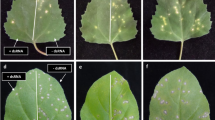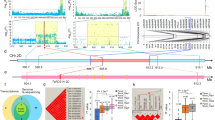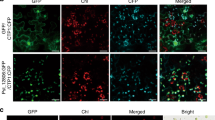Abstract
We generated transgenic tobacco plants expressing the sense or antisense untranslatable N coding sequence of the lettuce isolate of tomato spotted wilt virus (TSWV-BL) as well as transgenic plants containing the promoterless N gene of the virus. Both sense and antisense untranslatable N gene RNAs provided protection against homologous and closely related isolates but not against distantly related Tospoviruses. These RNA-mediated protections were most effective in plants that synthesized low levels of the respective RNA species and appears to be achieved through the inhibition of viral replication. Unlike the sense RNA-mediated protection, the level of the antisense RNA-mediated protection depended on the concentration of the inoculum and the size of the test plants. Comparisons with previous results in transgenic plants expressing the intact N gene suggest that resistance to homologous and closely related TSWV isolates in plants that express low levels of the translatable N gene is due to the presence of the N gene transcript and not the N protein. In contrast, resistance to distantly related Tospoviruses is due to accumulation of high levels of the N protein and not due to the presence of the N gene transcript.
This is a preview of subscription content, access via your institution
Access options
Subscribe to this journal
Receive 12 print issues and online access
$209.00 per year
only $17.42 per issue
Buy this article
- Purchase on Springer Link
- Instant access to full article PDF
Prices may be subject to local taxes which are calculated during checkout
Similar content being viewed by others
References
Francki, R.I.B., Fauquet, C.M., Knudson, D.L. and Brown, F. 1991. Classification and nomenclature of viruses. Fifth report of the international committee on taxonomy of viruses. Archives of Virology, Supplementum 2, pp. 281–283.
Elliott, R.M. 1990. Molecular biology of the Bunyaviridae. J. Gen. Virol. 71: 501–522.
Cho, J.J., Mau, R.F.L., German, T.L., Hartman, R.W., Yudin, L.S., Gonsalves, D. and Provvidenti, R. 1989. A multidisciplinary approach to management of tomato spotted wilt virus in Hawaii. Plant Disease 73: 375–383.
Law, M.D. and Mover, J.W. 1990. A tomato spotted wilt-like virus with a serologically distinct N protein. J. Gen. Virol. 71: 933–938.
German, T.L., Ullman, D.E. and Moyer, J.W. 1992. Tospoviruses: diagnosis, molecular biology, phytogeny, and vector relationships. Ann. Rew. Phytopathol. 30: 315–348.
Mohamed, N.A., Randles, J.W. and Francki, I.I.B. 1973. Protein composition of tomato spotted wilt virus. Virol. 56: 12–21.
Tas, P.W.L., Boerjan, M.L. and Peters, D. 1977. The structural proteins of tomato spotted wilt virus. J. Gen. Virol. 36: 267–279.
de Haan, P., Kormelink, R., De Oliveira Resende, R., Van Poelwijk, F., Peters, D. and Goldbach, R. 1991. Tomato spotted wilt virus L RNA encodes a putative RNA polymerase. J. Gen. Virol. 71: 2207–2216.
Law, M.D., Speck, J. and Moyer, J.W. 1992. The nucleotide sequence and genomic organization of the impatiens necrotic spot tospovirus M RNA. Virology 188: 732–741.
Kormelink, R., de Haan, P., Meurs, C., Peters, D. and Goldbach, R. 1992. The nucleotide sequence of the M RNA segment of tomato spotted wilt virus, a bunyavirus with two ambisense RNA segments. J. Gen. Virol. 73: 2795–2804.
de Haan, P., Wagemakers, L., Peters, D. and Goldbach, R. 1990. The S RNA segment of tomato spotted wilt virus has an ambisense character. J. Gen. Virol. 71: 001–007.
Law, M.D., Speck, J. and Moyer, J.W. 1991. Nucleotide sequence of the 3′ non-coding region and N gene of the S RNA of a serologically distinct Tospovirus. J. Gen. Virol. 72: 2597–2601.
Maiss, E., Ivanova, L., Breyel, E. and Adam, G. 1991. Cloning and sequencing of the S RNA from a Bulgarian isolate of tomato spotted wilt virus. J. Gen. Virol. 72: 461–464.
Pang, S.-Z., Slightom, J.L. and Gonsalves, D. 1993. The biological properties of a distinct Tospovirus and sequence analysis of its S RNA. Phytopathology In press
Chohan, J.S. 1972. Final Progr. Rep. ICAR Scheme Res. Important Dis. Groundnut in the Punjab for the Period 1957-1967. Dep. Plant Pathol., Punjab Agric. Univ., Ludiana, p. 177.
Ghanekar, A.M., Reddy, D.V.R., Iizuka, N., Amin, P.W. and Gibbons, R.W. 1979. Bud necrosis of groundnut (Arachis hypogaea) in India caused by tomato spotted wilt virus. Ann. Appl. Biol. 93: 173–79.
Iwaki, M., Honda, Y., Hanada, K., Tochihara, H., Yonaha, T., Hokama, K. and Yokoyama, T. 1984. Silver mottle disease of watermelon caused by tomato spotted wilt virus. Plant Disease 68: 1006–1008.
de Avila, A.C., Huguenot, C., Resende, R.deO., Kitajima, E.W., Goldbach, R.W. and Peters, D. 1990. Serological differentiation of 20 isolates of tomato spotted wilt virus. J. Gen. Virol. 71: 2801–7.
Reddy, D.V.R., Sudarshana, A.S., Ratna, A.S., Reddy, A.S. and Amin, P.W. 1991. The occurrence of yellow spot virus, a member of tomato spotted wilt virus group, on peanut (Arachia hypogaea L.) in India. USDA workshop, US Dep. Agric. Agric. Res. Serv., ARS, p. 77–88.
Adam, G., Lesemann, D.E. and Vetten, H.J. 1991. Monoclonal antibodies against tomato spotted wilt virus: characterization and application. Ann. Appl. Biol. 118: 87–104.
Kameyi-Iwake, M., Hanada, K., Honda, K. and Tochihara, H. 1988. A watermelon strain of tomato spotted wilt virus (TSWV-W) and some properties of its nucleocapsid. Int. Congr. Plant Pathol., 5th, Kyoto, Japan.
Yeh, S.-D., Lin, Y.-C., Cheng, Y.-H., Jin, C.-L. and Chen, M.-J. 1992. Identification of tomato spotted wilt-like virus on watermelon in Taiwan. Plant Disease 76: 835–840.
Wang, M. and Gonsalves, D. 1990. ELISA detection of various tomato spotted wilt virus isolates using specific antisera to structural proteins of the virus. Plant Disease 74: 154–158.
de Avila, A.C., de Haan, P., Kormelink, R., Resende, R.de O., Goldbach, R.W. and Peters, D. 1993. Classification of tospoviruses based on phytogeny of nucleoprotein gene sequences. J. Gen. Virol. 74: 153–159.
Sanford, J.C. and Johnston, S.A. 1985. The concept of parasite-derived resistance-deriving resistance genes from the parasite's own genome. J. Theor. Biol. 113: 395–405.
Hull, R. and Davies, J.W. 1992. Approaches to nonconventional control of plant virus diseases. Critical Reviews in Plant Sciences 11: 17–33.
Golemboski, D.B., Lomonossoff, G.P. and Zaitlin, M. 1990. Plants transformed with a tobacco mosaic virus nonstructural gene sequence are resistant to the virus. Proc. Natl. Acad. Sci. USA 87: 6311–6315.
Braun, C.J. and Hemenway, C.L. 1992. Expression of amino-terminal portions or full-length viral replicase genes in transgenic plants confers resistance to potato virus X infection. The Plant Cell 4: 735–744.
Kawchuk, L.M., Martin, R.R. and McPherson, J. 1991. Sense and antisense RNA-mediated resistance to potato leafroll virus in russet burbank potato plants. Mol. Plant-Microbe Interact. 4: 247–253.
Lindbo, J.A. and Dougherty, W.G. 1992. Pathogen-derived resistance to a potyvirus: immune and resistant phenotypes in transgenic tobacco expressing altered forms of a potyvirus coat protein nucleotide sequence. Mol. Plant-Microbe Interact. 5: 144–153.
Lindbo, J.A. and Dougherty, W.G. 1992. Untranslatable transcripts of the tobacco etch virus coat protein gene sequence can interfere with tobacco etch virus replication in transgenic plants and protoplasts. Virology 189: 725–733.
de Haan, P., Gielen, J.J.L., Prins, M., Wijkamp, I.G., van Schepen, A., Peters, D., van Grinsven, M.Q.J.M. and Goldbach, R. 1992. Characterization of RNA-mediated resistance to tomato spotted wilt virus in transgenic tobacco plants. Bio/Technology 10: 1133–1137.
Gielen, J.J.L., de Haan, P., Kool, A.J., Peters, D., van Grinsven, M.Q.J.M. and Goldbach, R.W. 1991. Engineered resistance to tomato spotted wilt virus, a negative-strand RNA virus. Bio/Technology 9: 1363–1367.
MacKenzie, D.J. and Ellis, P.J. 1992. Resistance to tomato spotted wilt virus infection in transgenic tobacco expressing the viral nucleocapsid gene. Mol. Plant-Microbe Interact. 5: 34–40.
Pang, S.-Z., Nagpala, P., Wang, M., Slightom, J.L. and Gonsalves, D. 1992. Resistance to heterologous isolates of tomato spotted wilt virus in transgenic tobacco expressing its nucleocapsid protein gene. Phytopathology 82: 1223–1229.
Ow, D.W., Jacobs, J.D. and Howell, S.H. 1987. Functional regions of the cauliflower mosaic virus 35S RNA promoter determined by use of the firefly luciferase gene as a reporter of promoter activity. Proc. Natl. Acad. Sci. USA. 84: 4870–4874.
Rochow, W.F. 1970. Barley yellow dwarf virus: phenotypic mixing and vector specificity. Science 167: 875–878.
Bourdin, D. and Lecoq, H. 1991. Evidence that heteroencapsidation between two potyviruses is involved in aphid transmission of a non-aphid-transmissible isolate from mixed infections. Phytopathol. 81: 1459–1464.
Osbourn, J.K., Sakar, S. and Wilson, M.A. 1990. Complementation of coat protein-defective TMV mutants in transgenic tobacco plants expressing TMV coat protein. Virology 179: 921–925.
Holt, C.A. and Beachy, R.N. 1991. In vivo complementation of infectious transcripts from mutant tobacco mosaic virus cDNAs in transgenic plants. Virology 181: 109–117.
Farinelli, L., Malnoe, P. and Collet, G.F. 1992. Heterologous encapsidation of patato virus Y strain O (PVY°) with the transgenic coat protein of PVY strain N (PVYn) in Solarium tulerosum cv. Bintje. Bio/Technology 10: 1020–1025.
Pang, S.-Z., Rasmussen, J., Ye, G.N. and Sanford, J.C. 1992. Use of the signal peptide of Pisum vicilin to translocate β-glucuronidase in Nicotiana tabacum Gene 112: 229–234.
Holsters, M., Waele, D., Depicker, A., Messens, E., Montagu, M. and Schell, J. 1978. Transfection and transformation of Agrobacterium tumefaciens. Mol. Gen. Genet. 163: 181–187.
Horsch, R.B., Fry, J.E., Hoffman, N.L., Eichholtz, D., Rogers, S.G. and Fraley, R.T. 1985. A simple and general method for transferring genes into plants. Science 227: 1229–1231.
Gonsalves, D. and Trujillo, E.E. 1986. Tomato spotted wilt virus in papaya and detection of the virus by ELISA. Plant Disease 70: 501–506.
Napoli, C., Lemieux, C. and Jorgensen, R. 1990. Introduction of a chimeric chalcone synthase gene into petunia results in reversible co-suppression of homologous genes in trans. The Plant cell 2: 279–289.
Sambrook, J., Fritsch, E.F. and Maniatis, T. 1989. Molecular Cloning: A Laboratory Manual. Cold Spring Harbor Laboratory Press, NY.
Negy, J.I. and Maliga, P. 1976. Callus induction and plant regeneration from mesophyll protoplasts of Nicotiana sylvestris. Z. Pflanzenphysiol. 78: 453–455.
Negrutiu, I., Shillito, R., Potrykus, I., Biasini, G. and Sala, F. 1987. Hybrid genes in the analysis of transformation conditions. Plant Mol. Biol. 8: 363–373.
Author information
Authors and Affiliations
Rights and permissions
About this article
Cite this article
Pang, SZ., Slightom, J. & Gonsalves, D. Different Mechanisms Protect Transgenic Tobacco Against Tomato Spotted Wilt and Impatiens Necrotic Spot Tospoviruses. Nat Biotechnol 11, 819–824 (1993). https://doi.org/10.1038/nbt0793-819
Received:
Accepted:
Issue Date:
DOI: https://doi.org/10.1038/nbt0793-819
This article is cited by
-
Untranslatable tospoviral NSs fragment coupled with L conserved region enhances transgenic resistance against the homologous virus and a serologically unrelated tospovirus
Transgenic Research (2015)
-
Transgenic resistance by N gene of a Peanut bud necrosis virus isolate of characteristic phylogeny
Virus Genes (2009)



